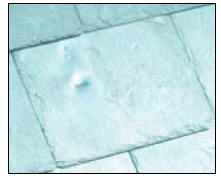 |
 |
 |
 |
 |
 |
 |
|
Check out our web directory of the UK
roofing and cladding industry
www.roofinfo.co.uk |
Sign up for our monthly news letter. |
|
|
|
|
|
 In the roofing industry we all refer to
slates and tiles and know which is which. But do other sections of the
construction industry define the terms roofing slate and roof tile in
the same way and who is right?
If we look at roofing products that are called
slates it is hard to decide if they are a roofing slate, or a roof tile
that looks like a slate. If being flat and laid to a double lapped
pattern defines a roofing product as a roofing slate, then shingles and
shakes should be wooden roofing slates. If slates have no nibs and tiles
do, then Kent peg tiles would be clay roofing slates.
Natural slate
In its purest form roofing slates are dark coloured pieces of
metamorphic rock. The origin of the rock is clay, silt, shale or
volcanic ash that has been heated and compressed over millions of years
to form what we know as slate. The rock is smooth and strong and can be
split into sheets 4-15mm thick, before being cut into a rectangular
shape. Premier roofing slates come from the West Coast of the UK from
Cornwall, through North Wales, Cumbria and into Scotland. Whilst some
imported slate is metamorphic rock, the rest is sedimentary rock and may
not have the same qualities as metamorphic rock. Each piece of rock laps
over the piece of rock below in a pattern called double lapping. On a
sloping roof, water draining down the roof is not prevented from
draining into the vertical joints, but any water that does will be
guided out again.
Stone slate
Stone slates are formed of sedimentary rock, such as limestone or
sandstone, which is naturally found, or dressed, into slabs of a
thickness of between 19-35mm. The slabs vary in surface texture, being
rougher and lighter in colour than natural slate. Being rectangular they
are laid double lapped like natural slates, with the exception that they
are not center nailed; being very heavy they only require head nailing.
Copies
All other roofing materials that are called roofing slates are
copies of the natural or stone slate, either in true size and texture or
in the laid finished appearance.
Double lap slates
Fibre cement: the ability to manufacture fibre cement into
sheets 4mm thick provides a material that can be cut into rectangular
pieces very close in appearance to natural slate. However, the rigidity
of the material is lower and therefore requires the tail of the slates
to be held down with a copper rivet. In all other respects it can be
used as a direct replacement for natural slate, but at a lower cost and
shorter life expectancy.
Concrete: some concrete roofing slates are designed to look like
thick natural or stone slates. They are produced in various colours and
sizes both with and without nibs but tend to weather differently due to
the cement content.
Resin slate: resin slates developed from the need to manage the
vast quantities of slate waste by grinding and mixing it with resin
before moulding back into an exact replica of a natural slate.
|
 |
The material contains a high proportion of
slate and has the colour, texture and strength of natural slate, making
it the closest copy of a natural slate that you can get.
Rubber: rubber slates developed from the need to manage the vast
quantities of rubber waste from old car tyres. The resulting slates look
very similar to natural slates. However they are not as rigid as natural
slate and therefore vulnerable to slapping up and down in high winds
unless the leading edge is restrained.
Single lap slates: these can be clay, concrete, polymer-concrete
or resin slate. They developed from single lap clay Roman roof tiles,
the top surface of which has been flattened and the interlock formed
within the thickness of the slate. Whilst some single lap roofing slates
can be laid straight bond, they look best when laid broken bond to mimic
double lap natural slates. Single lap slates are in all respects a tile
with a flat upper surface. Logic would therefore suggest that single lap
resin slates should be called slate tiles. Clay, concrete and polymer
concrete single lap slates may look like slates once installed, but are
roofing slates in name only.
Bitumen: these are strips of roofing felt finished with a surface
of slate granules. The strips of felt have slits cut into the leading
edge to make them look like a row of slates. To fix them they are nailed
and glued to a flatboarded roof surface. Apart from the slate chippings
and the flat appearance they are in all other respects a bituminous flat
roofing product laid on a pitched roof.
Metal: these slates are strips of sheet metal pressed into the
shape of a row of thick roofing slates and coated with a form of paint
or chippings. Metal slates may look like slates from a great distance,
but in all other respects they are metal profiled sheeting.
Conclusion
For a roofing product to be called a slate it should be flat on the
upper surface and laid to a double lapped pattern. It should be made of
stone or a mineral-derived product, such as resin slate, concrete or
clay. It should be slate or stone coloured and have a leading edge
thickness of between 4mm and 35mm. Anything that does not fit this
description may be called a roofing slate or be designed to look like a
roofing slate when laid on a roof, but is not a roofing slate. To
confuse matters some products that do fit this description are still
called roof tiles. |
|
Compiled by Chris Thomas, The Tiled
Roofing Consultancy, 2 Ridlands Grove, Limpsfield Chart, Oxted, Surrey,
RH8 0ST, tel 01883 724774 |
|